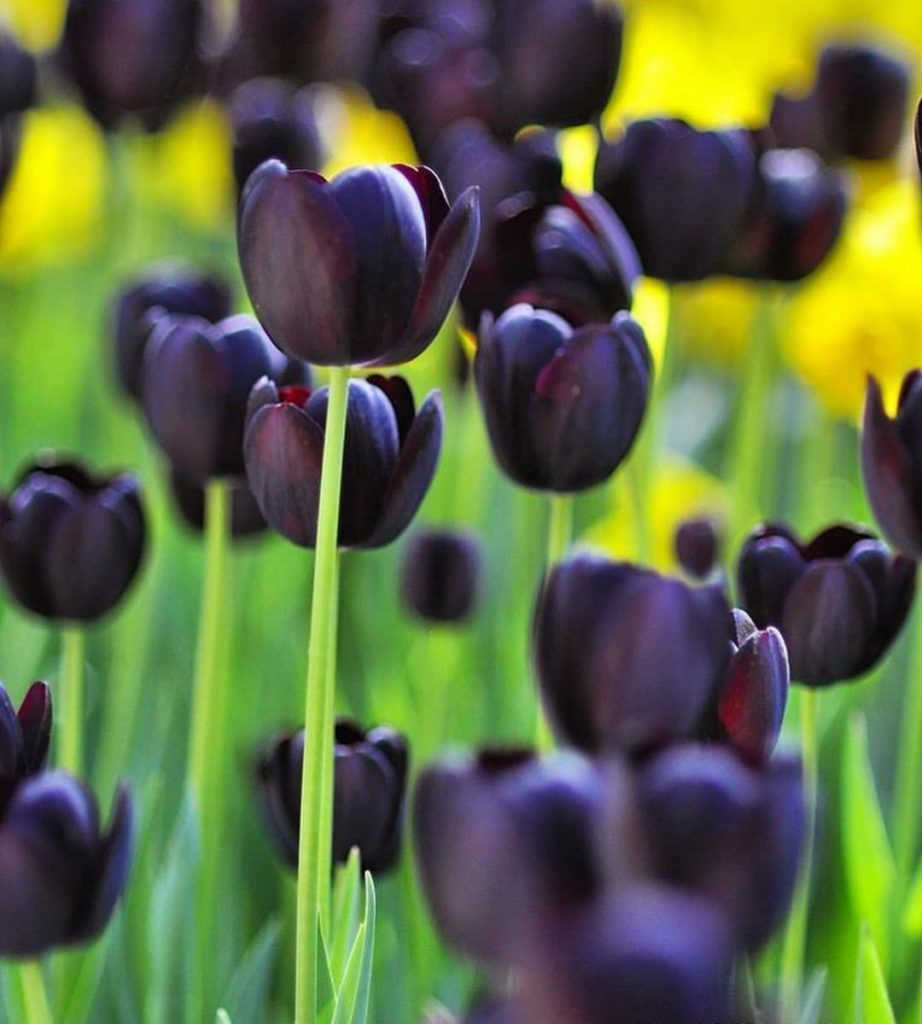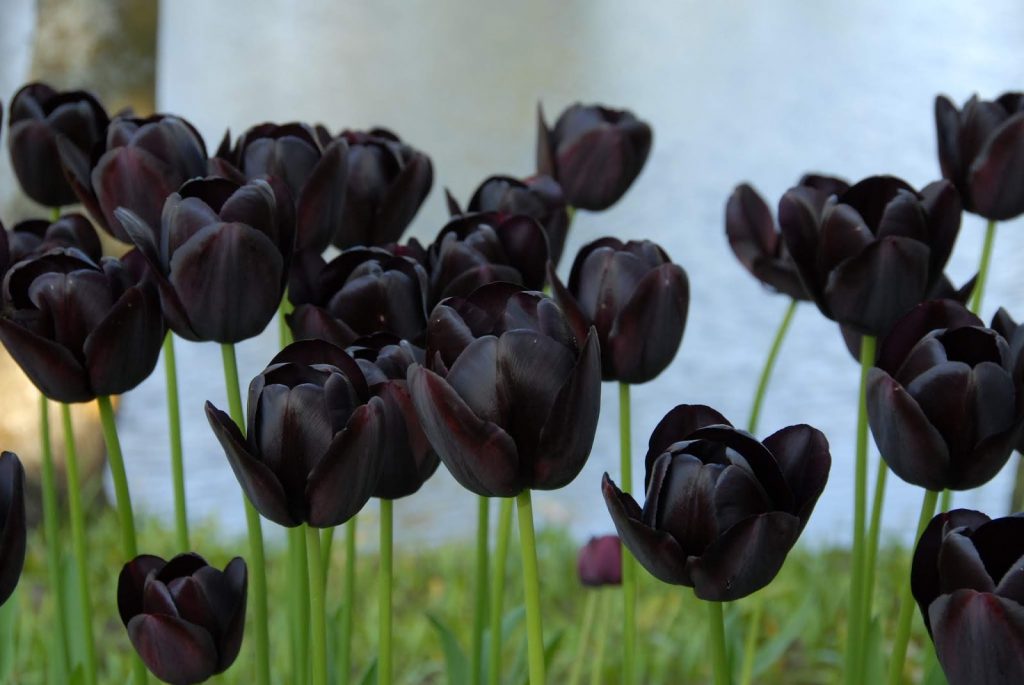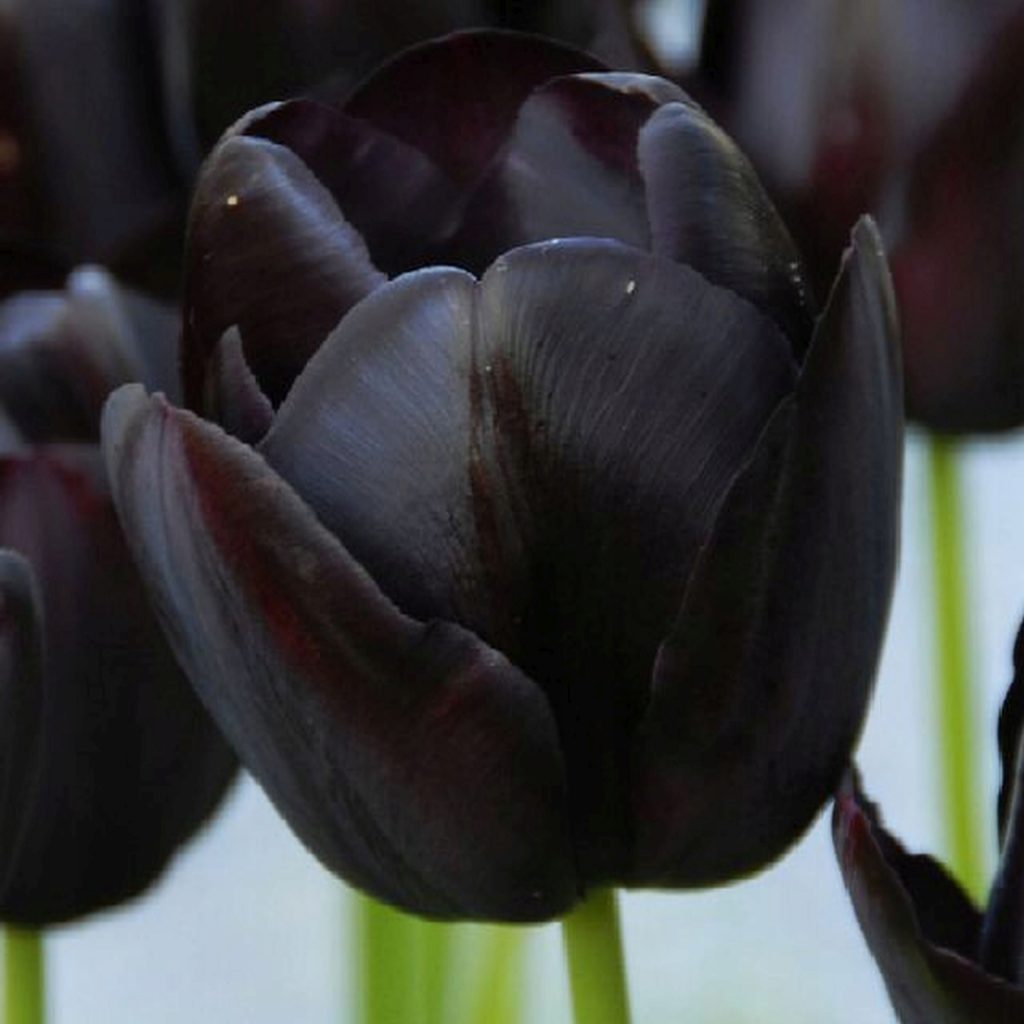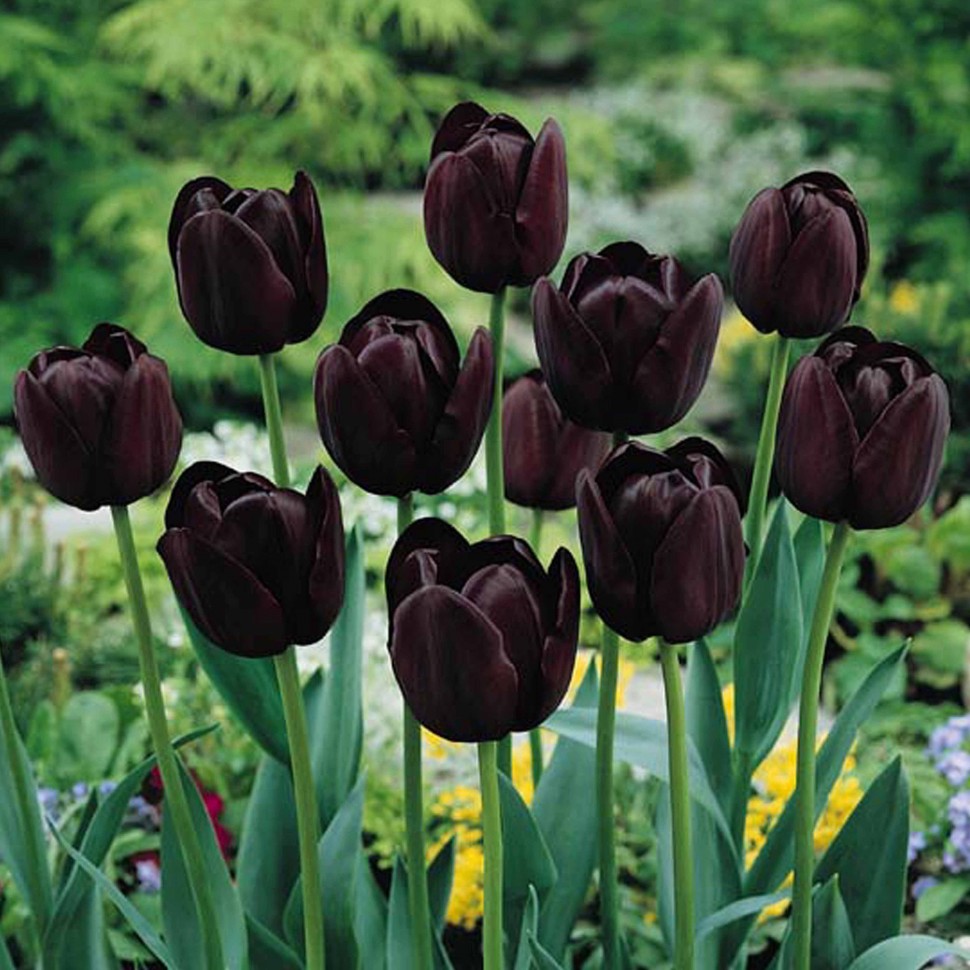Black tulips - popular varieties
Black tulip is the name of several decorative varieties with black-blue, dark purple or burgundy colors. The first mention of it dates back to the middle of the 17th century. However, the flower was officially introduced in the Netherlands 300 years later, at the end of the 20th century, after which it gained popularity in floriculture.

What is a black tulip
Main characteristics
The valley of black wild tulips is located in Abkhazia in alpine meadows. Flowering occurs in April-June.
The stem is erect, the shape is classical cylindrical. The average height is 10-100 cm.
The leaves are elongated, the surface is waxy, the color is green with a bluish tinge, the arrangement is alternate, in the upper part a small leaf plate is formed, called the flag leaf.
The bud is one, the color is in dark shades - purple, burgundy, blue, close to black, the shape of the flower depends on the variety - goblet, cupped, peony, fringed, oval, star-shaped.
The length of the head is about 12 cm, the diameter is from 4 to 10 cm, when fully expanded it reaches 20 cm, the perianth is formed by six petals, the number of stamens with long anthers is 6.
Seeds are brown, flat triangular in shape.
Description of varieties
Several varieties of tulips have been bred, the colors of which, depending on the light falling on the bud, are more or less close to black.

Black tulip photo flower
- Black jack. The color is dark lilac. Belongs to the large varietal group Triumph. The shape of the heads is goblet, the opening is partial even at the stage of polo maturation. Height 40-60 cm. Flowering period - April-May. The main application is for cutting.
- Ronaldo. The color is maroon. The surface of the petals is velvety. Included in the Triumph variety group. The average length of the head is 10 cm. The height is 40-60 cm. The shape of the bud is goblet. Blooms in April - May. Suitable for landscaping.
- Queen of night. It has the darkest, almost black shade with a burgundy tint. The shape of the buds is goblet, about 11 cm long, partially reveals at the stage of full maturation. Height up to 70 cm. Differs in long, up to 3 weeks, flowering, which begins in May. Suitable for landscaping.
- Black and white. Included among the variegated varieties of the Rembrandt varietal group. They stand out with an unusual white border against the background of the main dark burgundy color. Height 40-70 cm. The shape of the bud is goblet, full disclosure in good light. The flowering period is in May.
- Black hero. It is one of the terry varieties, called pion-like because of the unusual structure of the bud. The head is formed from 16-20 petals, length 89 cm, when fully expanded, the diameter is up to 12 cm. Height is 50-60 cm. It blooms from the end of May. The main application is for cutting.
- Black parrot. Get the name of the black parrot because of the unusual, jagged, wavy edges that look like bird feathers.The color is dark burgundy. Height 45-50 cm. The shape of the bud is star-shaped, height 10 cm, the diameter at full opening reaches 20 cm. It is distinguished by long flowering, up to 3 weeks, which begins in the end of May. Suitable for cutting and landscaping.
- Cuban night. Refers to fringed tulips. The buds are formed by black-burgundy or black-purple petals with needle-like edging. Height about 55 cm. It blooms in May. Grown for decorating flower beds, suitable for cutting.
- Black beauty. Black with burgundy tint. Belongs to late-flowering varieties, budding begins in late May. Height 65-70 cm. The shape of the buds is goblet.
Growing features
Ground requirements
For black tulips, a fertile sandy soil of neutral or weak acidity with high air permeability and moisture absorption is required. Acidic soil is brought to the required state by adding limestone.

Black tulips
Lighting
The planting site is chosen depending on the varietal accessory. A black tulip can grow equally well both in a sunlit area and in partial shade. When planted in full shade, the flowers lose their decorative effect.
Humidity
The flower culture is susceptible to moisture stagnation. The place is chosen with a low groundwater flow, avoiding lowlands where rainwater accumulates.
Landing rules
Tulips are planted mainly in autumn in order to achieve flowering in the coming season. When planting in spring, the culture will begin to bloom only after a year. Traditionally, the bulbs are planted from late August to early October.
It is necessary to complete the planting while the soil temperature is at least 7 ° C-10 ° C at a depth of about 10 cm, 3-4 weeks before the expected date of the arrival of the first frost.
Seat selection
For planting, choose a site where potatoes, tomatoes, eggplants were not previously grown, because these crops are prone to the same diseases. The ridges are prepared 2-3 weeks before planting the bulbs, digging up the soil and applying fertilizers.
Preparation of planting material
For planting, use the planting material obtained in the previous season or purchased in a specialized store. The bulbs are inspected for lesions and rotten areas. Before planting, they are treated with a fungicide or a weak pink solution of potassium permanganate (potassium permanganate).

Black tulip year
Technology
The bulbs are planted 10 cm apart and 20 cm apart between rows. The planting depth depends on the condition of the soil - on light ones by 3 diameters, on heavy ones - by 2 diameters of the root tuber.
About 50 large-sized bulbs are usually planted per 1 m².
The earth is not compacted, leaving air voids, the surface is leveled. After disembarkation, it is mulched.
Care rules
Tulip care begins when the first shoots appear.

Black tulip year by
Watering
Abundant watering is required at the stage of bud formation, during the entire period of budding and for 2 weeks after its completion. The basic rule is to water as the soil dries out, avoiding stagnation of water. Consumption rate per 1 m² depends on weather conditions and can range from 15 to 40 liters.
When watering, avoid getting water on the leaves to prevent sunburn. A day after the irrigation procedure, the soil is loosened in order to destroy the formed earthen crust and ensure the penetration of air to the root bulbs.
Top dressing
For feeding tulips, liquid fertilizers or solutions based on dry complexes are often used. Consumption rate - 30-50 g / m² plantings. Periodicity:
- the first procedure is carried out at the beginning of the growing season, when sprouts appear, formulations with an increased nitrogen content are used;
- the second time, the flower culture is fed before the onset of the budding stage, gradually reducing the proportion of nitrogen-containing complexes and increasing the amount of phosphorus and potassium, maintaining a ratio of 1: 2: 2;
- the third application is planned for the phase of full opening of the buds, using potassium-phosphorus complexes;
- at the end of budding, boron and zinc are added to feed the bulbs.
Pruning
At the end of flowering, pruning is organized:

Black tulip year is
- in order to preserve the bulbs for subsequent reproduction of the variety, the aerial part is cut off on the fifth or ninth day after the blooming of the buds - this will help provide the root tubers with enhanced nutrition;
- fallen petals are removed, especially those that remain in internodes - this will reduce the risk of developing decay processes;
- at the end of budding, the stems are not cut off completely, because bulbs need further growth;
- planting material is dug out after 2-4 weeks after the full opening of the buds.
Pruning does not need those flowers that do not need to save the root bulbs for subsequent planting. They are dug up along with the tubers.
Pre-winter preparation
Tulips are a frost-resistant bulbous culture. In regions with a lot of snowfall, plants planted in autumn do not need shelter. Mulching is used to protect against sudden temperature changes in areas with snowless winters.

Black tulips photo
For mulch, compost, peat mixture, straw or humus are suitable. The thickness of the layer is 5-15 cm. The plantings are closed at the final establishment of night frosts, when the soil begins to freeze.
Remove the mulch shelter after the snow melts.
Treatment of diseases and pests
Like all tulips, black varieties are susceptible to viral and fungal diseases. The greatest danger for them is the variegation virus, which manifests itself in the appearance of spotting, shading and stripes on the vegetative parts.
The specimens affected by a viral infection are not treated, but removed along with the bulb.
Common diseases of fungal etiology include gray and root rot. The main reasons for their spread are waterlogging of the soil. At the first signs of appearance, they organize watering with solutions based on fungicides.
Natural pests are bears, onion mites, snails and slugs. As a preventive measure to protect against harmful insects, traps are placed along the perimeter of the ridges and flowers that scare them away are planted - marigolds, calendula, mustard, etc.
In case of mass damage to a flower culture, spraying with insecticides is carried out.
Gardeners reviews
The black tulip has become popular in private gardening for its unusual appearance. They plant it more often as part of group compositions of 9 or more copies for the improvement of personal plots in flower beds and near paths. It is advisable to plant varieties with different budding periods in order to extend the decorative flowering for several months.

